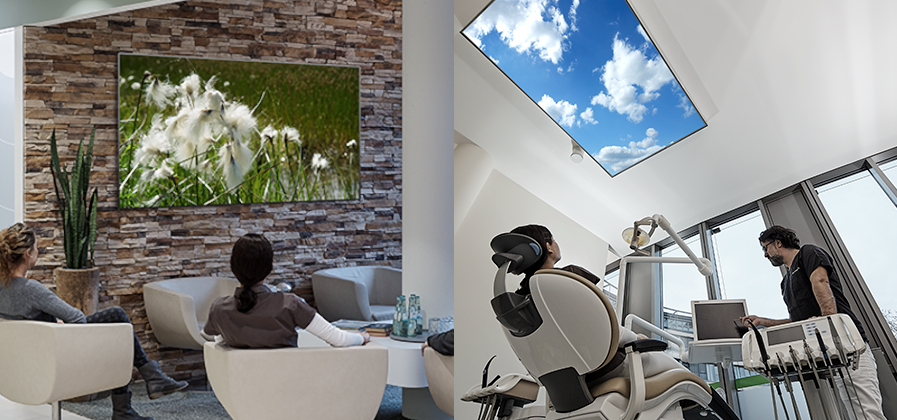As hospitals seek to woo patients in an increasingly consolidated and competitive healthcare environment, administrators are using patient-satisfaction scores and national rankings to create a point of differentiation and demonstrate their leadership. A recent survey of more than 1,000 hospital administrators co-published by The Beryl Institute and Catalyst Healthcare Research found the top priority—82 percent of all respondents—to be centered on improving the quality of the overall patient experience.
With cleanliness and security, among other essentials, being baseline expectations today, hospitals are now focusing on environmental factors to effectuate positive patient rankings. To that end, a plethora of data in the hospital/healthcare sector underscores the benefits of creating a patient waiting room environment that is rendered more calming through the integration of relaxation-inducing digital signage imagery.
A significant amount of research has focused on the calming effects of scenic nature images integrated into urban environments. This is foundational to the modern design field of biophilia, which centers on the fact that humans possess an innate tendency to seek connections with nature; moreover, when nature is integrated into urban settings, a measurable lowering of stress levels and anxiety can be observed.
Roger Ulrich, a noted researcher in the field of biophilia, has published studies on the positive effects of nature environments in hospital settings. A key goal was to discover if simulations—print and video imagery—had the same calming effect as physical manifestations did.
Ulrich’s “lab” was a redesigned hospital room that included a high-resolution mural of plants and animals in a colorful landscape that incorporated naturalistic fiber designs and colors, plants and organic materials. Pre- and post-test patient-stress measurements (blood pressure, heart rate, breathing rate) were taken. The results showed that significant reductions in stress, hostility and aggressive behavior among patients could be achieved by using simulated nature images.
Although the use of digital signage in healthcare environments is not new, the presence of dedicated digital signage display systems for biophilic content—and for relaxation-inducing imagery in general—is new.
For years, doctors, dentists and hospitals have placed displays in waiting rooms and patient-care areas to help reduce awareness of increasingly longer wait times to see a healthcare professional. Service providers that offer branded infomercials or “edutainment” digital signage systems designed to upsell or promote services, mixed in with other content, such as cable news or movies, have become commonplace. However, new research is beginning to reveal a surprising fact: Those types of educational and upsell-focused digital signage services in waiting rooms might well be contributing to patients’ anxiety levels.
Researchers at Cornell University studied the stress levels of patients in different environments, including one in which a TV news channel was running continuously. The study found that a majority of patients disliked the environment with the news-centric content, reporting that the sound was distracting and noisy, and that the content made them feel more stressed than they already were. Respondents who were exposed to waiting rooms that featured loops of branded commercials for services performed by the doctor or hospital were also unenthusiastic. Researchers deemed the reason to be that the use of infomercials as a potential distractor can lead to information and sensory overload, which contributes to feelings of stress and anxiety. Biophilic content, by contrast, does not produce those unintended negative consequences, instead inducing benefits associated with being more relaxed.
As medical/dental offices and hospitals that seek to attract new patients look beyond baseline expectations centered on cleanliness and security, the burgeoning trend of integrating relaxation-inducing imagery in waiting room digital signage display systems—in particular, biophilic sounds and images—will give AV integrators and hospital administrators a natural path to increased patient satisfaction and continued market growth.
